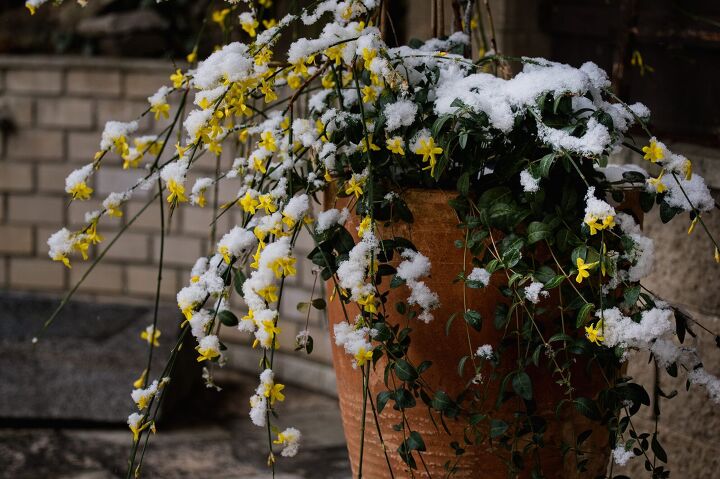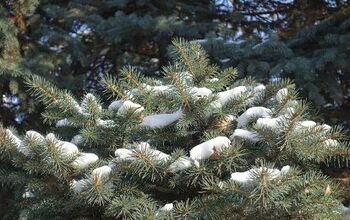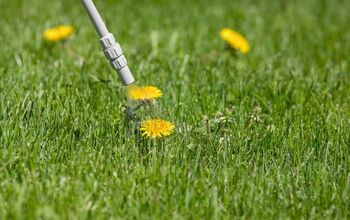How To Revive Plants After An Overnight Frost

Weather conditions these days are unpredictable. Just as there are record-high temperature records each year, there are also shocking cold snaps in unexpected places. These cold snaps can reach below freezing and happen rather suddenly. So, if there is an overnight frost, and you have left vulnerable plants outside, you will want to know what you can do to keep them alive.
If a vulnerable plant is outside during an overnight frost, bring it inside as soon as possible. Once the plant is protected, water it immediately with about an inch of water to rehydrate it. Do not fertilize the plant, as this can actually cause more damage to the frosted plant. As time goes on, use pruning sheers or scissors to cut off dead leaves and branches.
Leaving a plant outside unprotected during an overnight frost does not mean certain death. But it does mean you should act quickly. Be sure to read the following five steps to ensure you give your frosted plants every possible chance of survival.
Five Things To Do When Plants Freeze Overnight
1. Bring Plants Indoors (If Possible)
The first thing you should do once you realize a plant has been left out during an overnight frost is to bring it indoors and get it above freezing. In general, the less time a plant spends below freezing, the better its chances of survival.
While you might want to put it near a heater or even put a blow dryer on its frosted branches, don’t do this. It can actually damage the plant more. Instead, put it in its normal indoor location, like by the kitchen window, and let it come back up to room temperature.
2. Water The Plant Immediately
Once the plant is inside, you should water it as soon as possible. In general, it is best to give the plant an inch of water. When a plant freezes, the ice and frost that forms on it are actually a result of the cold tremperature pulling moisture out of its leaves and branches. This means the plant cells are damaged, but also the plant is incredibly dehydrated.
While you can’t change the damage done to the plant, you can instantly help hydrate it. You are bound to see some damage after a frost, but it is actually dehydration that causes a lot of potted plants to die after an overnight frost.
3. Fight The Urge To Add Fertilizer
You might come from the school of thought that fertilizer and plant growth substances really do work miracles. While this might be true when you are growing a plant from seed, adding fertilizers to plants that freeze overnight can actually cause further damage.
Recently frozen plants are very fragile. Bringing them into the home and giving them water are the initial steps to bringing them back to normal, and this is the goal. Adding fertilizer products can cause the plant to unnaturally grow new stalks and branches. This is bound to put undue stress on an already very tired plant. The result can cause the plant to work too hard, and die from exhaustion.
4. Trim Off Dead Leaves And Branches As They Appear
Once you defrost your plant, there is a good chance it won’t look damaged or dead right away. But the damage has been done. When plants freeze, the water turns to ice and expands, exploding plant cells and more. This damage rarely presents immediate visual signs.
Instead, you will likely see leaves shrivel or branches go limp. Then they will start to turn discolored and then die. This does not mean the entire plant is dead. There is a good chance the root structure and the plants’ main stalks, which are generally more resilient, have survived.
But once you see dead leaves or dead branches, you should remove them. Removing the dead parts of a plant help to preserve the parts that are still alive. A plant continues to send energy and resources to any part of the plant still connected. Therefore, cutting off dead parts helps save energy for the parts that are still healthy.
Pro Tip: Make sure you use pruning sheers or scissors when trimming branches. You don’t want to risk ripping bark or damaging healthy parts of the plant.
5. Remember Preventative Measures In The Future
Of course, hindsight is always 20/20, but do make sure that you use the frozen plants as a learning lesson. The best way to revive a plant after an overnight freeze is to take steps to prevent it from freezing in the first place. The good news is that all you can do is bring the plant inside or cover it. Even outdoor plants can survive an overnight freeze with proper preparation.
Reviving Rooted Outdoor Plants After An Overnight Freeze
If you are wondering if there is a difference between reviving an indoor plant and an outdoor plant after a freeze, the answer is – not really. The only major difference is you cannot bring the plant inside. The good news is, if you have an outdoor plant that has survived years outside, then the odds are this is not its first frost.
If, however, this is the plant’s first frost, try to follow similar steps. Once the frost has ended, water the plant. Then make sure you closely monitor it, watering it regularly. As pieces of it die, trim them off quickly. This should help ensure the plant survives.
Variables To Consider When A Plant Freezes Overnight
After an overnight frost, in addition to wanting to know how to revive a plant, you also want to know the likelihood it will survive. In order to have a better understanding of the likelihood of your plant’s survival, you need to consider the variables listed below.
- How Long It Was Frozen: In general, if temperatures just dip below freezing for an hour or two, then your plants are at a fairly low risk of dying, but an overnight frost that lasts until midday the next day, on the other hand, can really do some damage.
- How Low The Temperature Dropped: The lower the temperature, then the more area is likely frozen. If the soil, roots, and deep within the plant have all frozen due to very low temperatures, your plant is less likely to survive than if it was just below freezing.
- The Type Of Plant That Froze: Plants like banana trees and other tropical plants are only found in tropical areas because they have high water content and hate the cold. When these plants freeze, they are far more likely to die than plants used to cold like a rose bush.
- The Size And Age Of The Plant: In general, a larger, older plant has more stamina and ability to bounce back than a young sapling. Older plants tend to have thicker stalks and deeper roots, which help in a frost.
Summing Up Reviving Plants After An Overnight Frost
When your most beloved plants are left outside during an overnight frost, you don’t need to panic, but you do need to act quickly. If the plants are potted, bring them indoors to ensure they can thaw. Make sure you water them right away. As time goes on, make sure you trim the dead leaves and branches from the plant to ensure the healthy parts still thrive.
Related Guides:

Tom Gaffey is an expert writer who currently resides in Washington D.C. Tom has a passion for real estate and home improvement writing, as well as travel and lifestyle writing. He lived the last twelve years in Hawaii where he worked closely with luxury resorts and event planners, mastering his knowledge of aesthetics and luxury products. This is where he found his passion for home improvement and a keen interest in DIY projects. Currently, Tom resides in Washington D.C, and also working on his debut fiction novel.
More by Tom Gaffey













![The 10 Best Table Saws - [2022 Reviews & Buyer's Guide]](https://cdn-fastly.upgradedhome.com/media/2023/07/31/9070645/the-10-best-table-saws-2022-reviews-buyer-s-guide.jpg?size=350x220)













